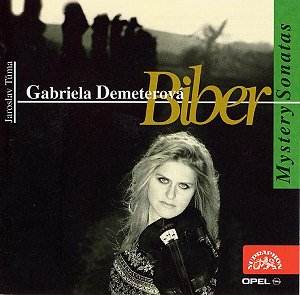 Composer: Heinrich Franz Biber
Composer: Heinrich Franz Biber
Works: Mystery Sonatas 1-7, Passacaglia
Performers: Gabriela Demeterova, violin; Jaroslav Tuma, organ
Recording: Mirror Chapel, Klementinum, Prague, March 1996
Label: Supraphon SU 3155-2131
Biber’s “Mystery Sonatas,” composed around 1674, arrive as remarkable explorations of spirituality through the lens of Baroque music, intertwining sacred themes with virtuosic violin writing. These fifteen sonatas, structured around the Joyful, Sorrowful, and Glorious Mysteries of the Virgin Mary and Christ, present a profound tapestry of emotion and narrative. Biber, a pioneer of scordatura—a retuning technique that expands the violin’s expressive range—invites performers to navigate a landscape marked by both technical challenges and deep introspection. This recording, performed by Czech violinist Gabriela Demeterova and organist Jaroslav Tuma, captures the essence of Biber’s intentions while offering a compelling interpretation.
Demeterova’s approach to the “Mystery Sonatas” is both lyrical and nuanced, breathing life into these deeply introspective works. In the opening movement of the Sonata devoted to the Visitation, she showcases a simplicity that belies the technical demands of the piece, evoking a genuine sense of contemplation that perfectly aligns with Biber’s spiritual vision. Her tone is light and airy, which, while modern in its articulation, maintains an authenticity that resonates with the Baroque idiom. The Allemande of the same sonata reveals her ability to balance emotion with clarity, as she navigates the intricate lines with grace and precision, perfectly complementing Tuma’s organ accompaniment.
Tuma’s role, while primarily supportive, is pivotal in shaping the overall interpretation. His organ playing exhibits a commendable restraint, allowing Demeterova to take the lead without overshadowing her. This dynamic is particularly effective in the Lamento of Sonata VI, where the organ’s subtle undercurrents enhance the emotional weight of the violin’s lament. Yet, there are moments, notably in the concluding Sarabande of Sonata VII, “Christ’s Flagellation,” where Tuma’s more vigorous interventions invite a consideration of whether a more assertive approach throughout could have enriched the performance’s dramatic impact. Despite this, the interplay between violin and organ remains a highlight, underscoring the depth of Biber’s writing.
The recording quality is exemplary, with the acoustics of the Mirror Chapel providing a resonant backdrop that enhances the clarity of both instruments. Each note is captured with a transparency that allows the listener to appreciate the intricate dialogue between Demeterova and Tuma. The engineering choices highlight the spatial relationships inherent in the music, particularly during the Passacaglia, which concludes the disc. Here, the unaccompanied violin weaves a complex web of sound, reflecting both the technical prowess required and the spiritual journey encapsulated in Biber’s work.
When compared to other recordings of the “Mystery Sonatas,” Demeterova and Tuma’s collaboration stands out for its intimate connection and interpretive sincerity. While some recordings employ a larger continuo group, the duo’s minimalist approach allows for a more focused exploration of Biber’s musical language. Their interpretation, while uniquely their own, remains faithful to the spirit of the Baroque, echoing the profound explorations found in Bach’s Passions while maintaining its distinct identity.
A compelling interplay of technical mastery and spiritual depth characterizes this recording of Biber’s “Mystery Sonatas.” Demeterova’s articulate violin work, coupled with Tuma’s sensitive organ playing, results in a performance that is both intellectually engaging and emotionally resonant. The recording not only honors Biber’s innovative spirit but also invites listeners to immerse themselves in the profound mysteries encapsulated in his music. This release is an essential addition for those seeking to explore the depths of Baroque expression.


